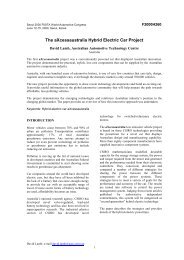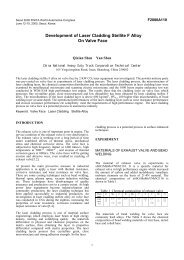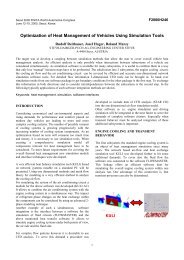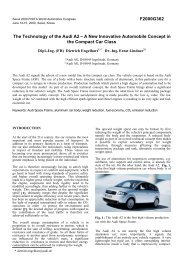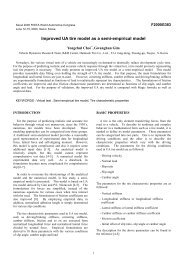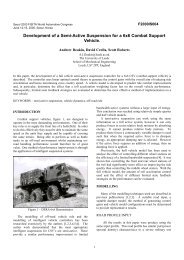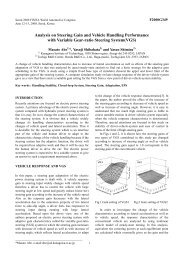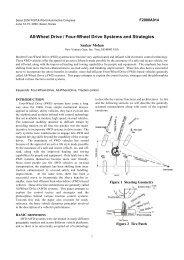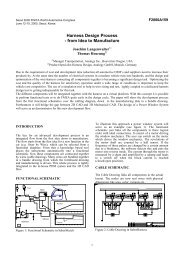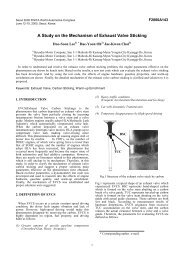Design and Simulation of Active Suspension System by Using Matlab
Design and Simulation of Active Suspension System by Using Matlab
Design and Simulation of Active Suspension System by Using Matlab
You also want an ePaper? Increase the reach of your titles
YUMPU automatically turns print PDFs into web optimized ePapers that Google loves.
time is very short, but that the response does not meet the5% overshoot requirement. We have solved this problemmultiplying K D, K P <strong>and</strong> K I <strong>by</strong> 2. Rerunning this m-file weshould get the following plot:Figure 5. Closed-Loop Response with PID ControllerFrom the graph, the percent overshoot is about 9,5%, whichis 4,5 % larger than the requirement, but the settling time issatisfactory - 3 sec. To choose the proper gain that yieldsreasonable output from the beginning, we start withchoosing a pole <strong>and</strong> two zeros for PID controller. A pole <strong>of</strong>this controller must be at zero <strong>and</strong> one <strong>of</strong> the zeros has to bevery close to the pole at the origin, at 1. The other zero, wewill put further from the first zero, at 3, actually we canadjust the second-zero's position to get the system to fulfillthe requirement. Let's add the following comm<strong>and</strong> in the m-file, so we can adjust the second-zero's location <strong>and</strong> choosethe gain to have a rough idea what gain you should use forK D, K P <strong>and</strong> K I .z1=1; z2=3; p1=0;numc=conv([1 z1],[1 z2]); denc=[1 p1];num2=conv(nump,numc);den2=conv(denp,denc);rlocus(num2,den2);[K,p]=rlocfind(num2,den2)We should see the close-loop poles <strong>and</strong> zeros on the s-planelike this <strong>and</strong> we can choose the gain <strong>and</strong> dominant poles onthe graph <strong>by</strong> ourselves:Figure 7. Closed-Loop Response with PID ControllerNow let's see if the percent overshoot <strong>and</strong> settling timemeet the initial requirements. The overshoot is about 5%,<strong>and</strong> the settling time is approximately 2,5s. For thisproblem, it turns out that the PID design method adequatelycontrols the system. This can be seen <strong>by</strong> looking at the rootlocus plot, for the task can be achieved <strong>by</strong> simply changingonly the gains <strong>of</strong> a PID controller.CONTROLLER DESIGN BY ROOT LOCUSMETHODThe necessary condition for the stability <strong>of</strong> a stationarycontinuous linear system with concentrated parametres isthat all the roots <strong>of</strong> its characteristic equation. have negativereal parts or, which is the same, lie in the left semi-plain <strong>of</strong>the complex s variable. Root locus design <strong>of</strong>fers thepossibility <strong>of</strong> adjusting the poles, zeros <strong>and</strong> transferfunction gain, so that, with closed feedback, the system getsthe desired dynamic characteristics [4]. Let us first see whatare the poles <strong>of</strong> the open-loop automatic control system:R roots(denp)=-23.7792+35.1432i-0.1098+5.2504i-23.7792-35.1432i-0.1098-5.2504iFigure 6. Root Locus with PID ControllerTherefore, the dominant poles are roots -0.1098±5.2504i,which are located close to the complex axis with a smalldamping ratio, <strong>and</strong> which have a dominant influence on theparametres <strong>of</strong> the transitional regime. The main idea <strong>of</strong> rootlocus design is to estimate the response <strong>of</strong> the closed-loopfrom the open-loop locus plot. By adding zeros <strong>and</strong>/or polesto the original system (adding a compensator), the rootlocus <strong>and</strong> thus the closed-loop response will be modified.Let's first view the root locus for the plant.Now that we have the close-loop transfer function,controlling the system is simply a matter <strong>of</strong> changing theK D, K p <strong>and</strong> K I variables. Figure 5. tells us that the settling5



